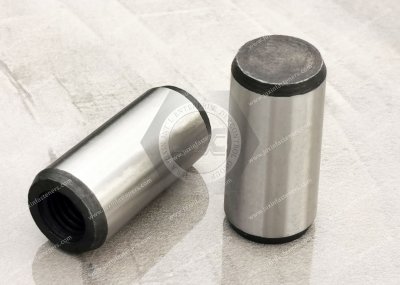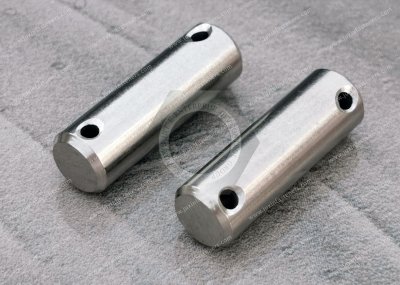Call Us
+86 136 6007 9809
Call Us
+86 136 6007 9809
Nov. 03, 2023
A stainless steel cotter pin is a metal hardware fastener, also known by its common name, spring pin! It is a mechanical part that can be lubricated in the pinhole to avoid damaging the hole wall.
They are usually made of high-quality steel, flexible material. A stainless steel cotter pin is a kind of steel metal hardware commonly known as a steel spring pin. The cotter pin's role in the threaded connection is to prevent loosening; insert the cotter pin into the nut groove, the bolt tail hole, and the cotter pin tail wrench to prevent the control rotation of the nut and bolt. The production of materials is generally Q235, copper alloy, SUS201 stainless steel, and SUS304 stainless steel. Stainless steel cotter pin material toughness requirements are relatively high; each foot's stainless steel cotter pin should withstand repeated bending, and the bending part should not break or crack. Bending method: pull the stainless steel cotter pin, any of its feet partially clamped in the test mold (should not occur flattening phenomenon); then the stainless steel cotter pin bending 90 °, back and forth once for a bending. Test speed should not exceed 60 times/min. The best mold should be made out of a semicircular groove hole, and its diameter is the nominal specifications of the cotter pin. The jaws should have a rounded corner of r=0.5mm.
What does stainless steel cotter pin mean?
A stainless steel cotter pin is a fastener widely used in mechanical equipment. It consists of two parts: cotter pin and pin ring, which are easy to use and quick to install and commonly used in electric equipment, pressure vessels, chemical pipelines, mechanical equipment, and other fields. And the quality standards and implementation standards of stainless steel cotter pins are equally important.
Toughness: each foot of the stainless steel cotter pin should withstand repeated bending many times without fracture or cracks in the bending part.
Bending method: pull the cotter pin, any straight foot part of the clamp in the test mold (should not occur flattening phenomenon); then the cotter pin bent 90 °, back and forth once for a bending. Test speed should not exceed 60 times/min. The best mold should be made out of a semicircular groove hole, and its diameter is the nominal specifications of the cotter pin. The jaws should have a rounded corner of r=0.5mm. Eyelets should be made as round as possible.
The cotter pin, which is two feet of the cross-section, should be round, but the promised cotter pin is two feet of the plane and the circumference of the intersection of the radius.
The two gaps and two feet of the wrong displacement of the Cotter pin should not be more significant than the pin's nominal specifications.
Cotter pins promised to be made of openings; the angle between the two feet of the inner plane should be in line with the specifications.
Surface defects: the surface of the cotter pin should be free of burrs, irregularities, and harmful defects.
The primary role of stainless steel cotter pins
They are used for threaded connections to prevent loosening. After the nut is tightened, the cotter pin is inserted into the nut groove, and the bolt tail hole and the end of the cotter pin are wrenched away to prevent the relative rotation of the nut and the bolt.
For anti-loosening of threaded connections. After the nut is tightened, insert the cotter pin into the nut groove and the bolt tail hole, and wrench the end of the cotter pin away to prevent the relative rotation of the nut and the bolt. The standard range of cotter pins Nominal specifications for cotter pins are 0.6~20mm. Each foot of the cotter pin can withstand repeated multiple bends and does not break or crack in the bent portion. To avoid damage to the hole wall, lubricant can be added to the pin control; this part's production requires high-quality steel and flexible and rigid materials. Cotter pins are widely used in mechanical equipment. Mainly used for easy maintenance and disassembly of the axle, such as connecting the part with the pin, the general shaft stops most of the use of cotter pins to fix the pin.


Stainless steel cotter pin installation method
1. Insert the stainless steel cotter pin into the cylindrical pin by hand or pliers, and do not drive the cotter pin in with a hammer.
2. Use a screwdriver to break the stainless steel cotter pin.
3. The angle of breaking the cotter pin is 60° in principle. The stainless steel cotter pin can be rolled up if it touches the workpiece.
4. Make the separate parts straight and symmetrical When the stainless steel cotter pin is opened. It cannot be long or short with an R shape and on the gap.
5. When fixing the slotted nut, the opening angle of the stainless steel cotter pin is 60° in principle, and it is appropriate to screw and roll up a few turns. However, the stainless steel cotter pin should be rolled up when there is an obstruction or insufficient insulation distance from the surroundings.
Stainless steel cotter pin installation specifications
1. The stainless steel cotter pins used should not be broken, cracked, rusted, and so on;
2. The nominal specification of the stainless steel cotter pin should be equal to the diameter of the stainless steel cotter pin hole;
3. Should be split by the root tight so that the stainless steel cotter pin does not tamper;
4. Stainless steel cotter pin opening must be symmetrical, two feet after splitting, and must be rolled in the round pin or shaft so that the arc of the split part of the arc and the round pin or shaft are parallel to the arc of the round pin or shaft as close as possible to the round pin or shaft so that the angle of the two openings > 180 °;
5. Replacing the stainless steel cotter pin with wire or other materials is strictly prohibited.
Stainless steel cotter pins
Definition and use of stainless steel cotter pin A stainless steel cotter pin is a metal connecting part usually used to connect mechanical parts with a fixed function. It is characterized by one end being cylindrical and the other being open, and it can be used with the cylinder. Stainless steel cotter pins are usually made of stainless steel material, with corrosion resistance, high hardness, long life and other characteristics, widely used in machinery, automotive, electronics, chemical industry and other fields, US304, SUS316 material hexagonal bolts, hexagonal cylindrical head bolts, double-head bolts, live bolts, flat round head square neck bolts, expansion bolts, anchor bolts, U-shaped bolts, dental strips, full-threaded small tooth bar. Fastening screws, flat round head machine screws, countersunk head machine screws, half round head hexagonal. Specifically, the implementation standards of stainless steel cotter pins mainly include the following aspects: DIN 94 stainless steel cotter pins and equivalent standards: ISO1234-1976 and ISO1234-1997.DIN EN ISO 1234,Q 500,ANSI/ASME B 18.8.1,ANSI/ASME B 18.8.6M,BS 1574,JIS B 1351,NF E 25-774,KS B 1321. Uni 1336, is 549 - 2005.
Also known as split pins, these have one prong slightly longer than the other, so they're easy to open. Bend the prongs outward to secure them. Use them to tie the ends of clevis pins and shafts to keep components in place.
Steel pins have good strength. Pins with a zinc-plated finish have some corrosion resistance. Pins with a cadmium yellow-chromate plated finish have good corrosion resistance and meet MS-24665 for dimensions, material, and finish.
18-8 stainless steel pins balance strength and corrosion resistance. They may be mildly magnetic. Passivated pins provide added protection against corrosion and oxidation.
Three hundred sixteen stainless steel pins have the best corrosion resistance of our stainless steel pins and are as strong as 18-8 stainless steel pins. They may be mildly magnetic.
Aluminum pins are one-third the weight of stainless steel pins and resist corrosion. They are nonmagnetic.
Brass pins are rust-resistant, electrically conductive, and nonmagnetic.
Four hundred nickel pins are solid and wear-resistant. They withstand salt water and caustic chemicals and may be mildly magnetic. Pins meet MS-24665 for dimensions, material, and finish. They are also known as Monel.
Quality standard of stainless steel cotter pin
A stainless steel cotter pin is a fastener widely used in mechanical equipment. It consists of two parts: a stainless steel cotter pin and pin ring, which is easy to use and quick to install and is widely used in electric power equipment, pressure vessels, chemical pipelines, and mechanical types of equipment. The quality and implementation standards of stainless steel cotter pins are equally important. In addition to the implementation standards, the quality standard of stainless steel cotter pins is similarly essential. Stainless steel cotter pins should comply with the provisions of the relevant national or industry standards, with unified labeling and anti-counterfeiting signs, to ensure that users can use them with peace of mind.
In summary, implementing stainless steel cotter pins and quality standards is critical, and its safe and reliable use is closely related. I hope this article can help readers understand the associated standards and norms of stainless steel cotter pins and better grasp the use of stainless steel cotter pins and purchase methods.
If you are looking for high-quality automotive fastener screws & all kinds of plastic fasteners or technical support for structural design, please get in touch with me. Use our new Product Finder tool, download our Product Catalog, and let us help you get custom parts.adelajonly@gmail.com. Thanks. Website: www.juxinfasteners.com
Contact Us
Tel.:
+86 020 8621 0320
+86 020 3121 6067
Technical Support:
Navigation
SEND INQUIREY